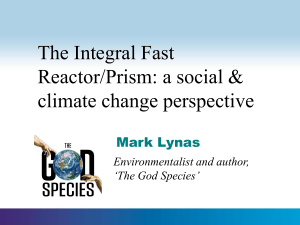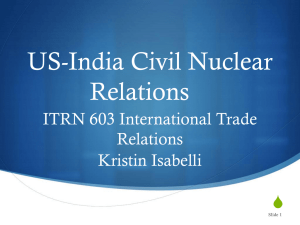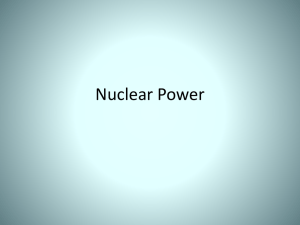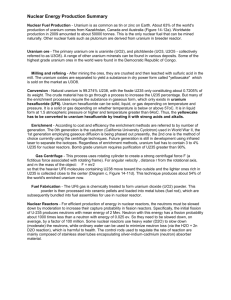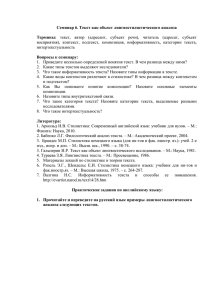Maxine Symington
advertisement
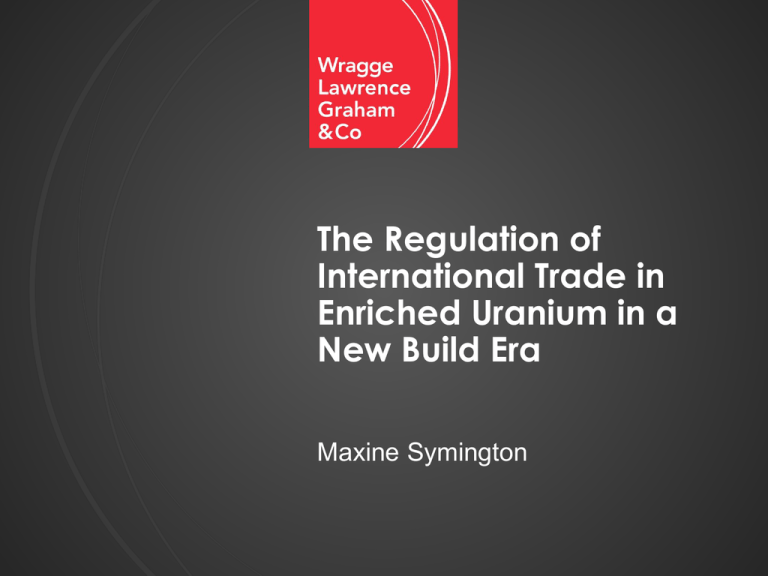
The Regulation of International Trade in Enriched Uranium in a New Build Era Maxine Symington Introduction Regulation of the international trade in enriched uranium has come a long way in a comparatively short time In a new build era what are the challenges, do we need to take stock? Proliferation- measures for control Time for a new approach? Uranium and the Nuclear Fuel Cycle Where is uranium mined? The largest producing Uranium mines in 2011 Mine Country Main owner Type Production (tU) % of world McArthur River Canada Cameco underground 7686 14 Olympic Dam Australia BHP Billiton by-product/ underground 3353 6 Arlit Niger Somair/ Areva open pit 2726 5 Tortkuduk Kazakhstan Katco JV/ Areva ISL 2608 5 Ranger Australia ERA (Rio Tinto 68%) open pit 2240 4 Kraznokamensk Russia ARMZ underground 2191 4 Budenovskoye 2 Kazakhstan Karatau JV/Kazatomprom-Uranium One ISL 2175 4 Rossing Namibia Rio Tinto (69%) open pit 1822 3 Inkai Kazakhstan Inkai JV/Cameco ISL 1602 3 South Inkai Kazakhstan Betpak Dala JV/ Uranium One ISL 1548 3 27,951 52% Top 10 total The balance between exploitation of atomic power for civil use and proliferation risk Post 1945 How to open up trade? How to control it safely? A bargain is struck in the hope of minimising proliferation A regulatory agency is set up Treaty on the Non-Proliferation of Nuclear Weapons 1970 The First Pillar The Second Pillar The Third Pillar Nonproliferation Art I&II NWS agree not to help NNWS develop or acquire nuclear weapons + Art III tasks IAEA with inspection of NNWS facilities Nuclear disarmament Art VI all parties to pursue disarmament Right of NNWS to use nuclear technology for peaceful purposes Art VI Article IV NPT "Parties to the Treaty in a position to do so shall also co-operate in contributing alone or together with other States or international organizations to the further development of the applications of nuclear energy for peaceful purposes, especially in the territories of non-nuclear-weapon States Party to the Treaty, with due consideration for the needs of the developing areas of the world." Definition, guidelines and co-operation Zangger Committee Indian Atomic Test Other cooperation agreements are signeddiversion is a concern Nuclear Suppliers Group S 123 Agreements Export Control/Dual Use Technology Timeline 1971 1974 1975 1977 1991 Tension between commerce and proliferation control NPT extension 9/11 2001 Fissile Material CutOff Treaty India is made an exception to the NPT Resolution 1887tightening of export control Timeline 1995 2001 2004 2005 2009 With Technology advances, definition of “export“ becomes wider New build era At the IAEA’s 56th General Conference 2012 Director General Amano noted that developing countries show keen interest in nuclear power. Some countries see states already benefitting from nuclear power, concerned about diversion of fissile material and nuclear technology for nuclear weapons development- particularly in relation to enrichment and reprocessing (E&R)- having a tendency to push the bar to entry ever higher. Is the safeguarding regime still fit for purpose in its current form? New ideas? A view from the European Commission Concern that potentially differentiated control standards of third countries may distort competition. Suggest an integrated, risk driven strategic trade control model. Vision involves, “human security”, “smart security” and development of an “EU technological reaction capacity”. Move to an effective response to use of cyberspace for proliferation. Emphasis on end use monitoring and traceability of intangible transfers of technology, self auditing and post transfer monitoring. Wider variety of export licences e.g. “low value shipments”, “encryption”, “Intra-company technology transfers”, and “large projects”. New ideas? The IAEA, a Multilateral Nuclear Approach (MNA) INFCIRC/640 2005 Expert Group Report. Five possible approaches: Range of transparent suppliers’ arrangements with government backing, such as fuel leasing and fuel take-back offers, commercial offers to store and dispose of spent fuel, and commercial fuel banks (in 2010 IAEA authorised set up of a low enriched uranium fuel bank as a supply of last resort). International supply guarantees with IAEA participation, Voluntary conversion of existing facilities to a multilateral nuclear approach (MNA). Creating multinational, regional MNAs for new facilities based on joint ownership for uranium enrichment, fuel reprocessing, disposal and storage of spent fuel. Consider up-scaling concept to nuclear fuel cycle with stronger multilateral arrangements by region or by continent involving the IAEA and international community. New ideas? ..from the Project on Managing The Atom (Harvard) Back to basics (Art IV) but offer incentives and opportunities as an alternative to national E&R. NSG should try to reach agreement on “clean text”. Revise trigger list and dual use controls. Promote fuel assurances and multinational control of E&R facilities. Recognise limitation of US-UAE model. Cradle to grave options for countries with small nuclear programs. Universal adoption of the Additional Protocol. R&D of more proliferation resistant fuel cycle technology. Diplomatic pressure. Conclusion Have we come full circle? www.wragge-law.com
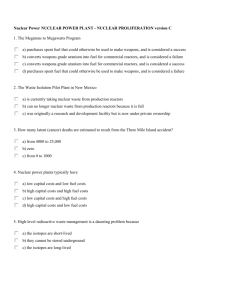




![The Politics of Protest [week 3]](http://s2.studylib.net/store/data/005229111_1-9491ac8e8d24cc184a2c9020ba192c97-300x300.png)

